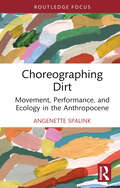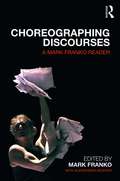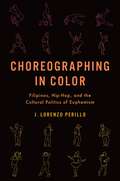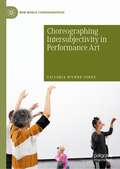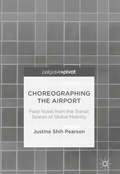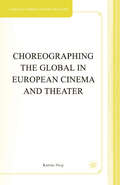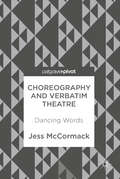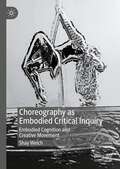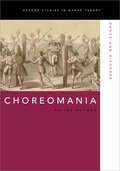- Table View
- List View
Choreographing Dirt: Movement, Performance, and Ecology in the Anthropocene (Routledge Studies in Theatre, Ecology, and Performance)
by Angenette SpalinkThis book is an innovative study that places performance and dance studies in conversation with ecology by exploring the significance of dirt in performance. Focusing on a range of 20th- and 21st-century performances that include modern dance, dance-theatre, Butoh, and everyday life, this book demonstrates how the choreography of dirt makes biological, geographical, and cultural meaning, what the author terms "biogeocultography". Whether it’s the Foundling Father digging into the earth’s strata in Suzan-Lori Park’s The America Play (1994), peat hurling through the air in Pina Bausch’s The Rite of Spring (1975), dancers frantically shovelling out fistfuls of dirt in Eveoke Dance Theatre’s Las Mariposas (2010), or Butoh performers dancing with fungi in Iván-Daniel Espinosa’s Messengers Divinos (2018), each example shows how the incorporation of dirt can reveal micro-level interactions between species – like the interplay between microscopic skin bacteria and soil protozoa – and macro-level interactions – like the transformation of peat to a greenhouse gas. By demonstrating the stakes of moving dirt, this book posits that performance can operate as a space to grapple with the multifaceted ecological dilemmas of the Anthropocene. This book will be of broad interest to both practitioners and researchers in theatre, performance studies, dance, ecocriticism, and the environmental humanities.
Choreographing Dirt: Movement, Performance, and Ecology in the Anthropocene (Routledge Studies in Theatre, Ecology, and Performance)
by Angenette SpalinkThis book is an innovative study that places performance and dance studies in conversation with ecology by exploring the significance of dirt in performance. Focusing on a range of 20th- and 21st-century performances that include modern dance, dance-theatre, Butoh, and everyday life, this book demonstrates how the choreography of dirt makes biological, geographical, and cultural meaning, what the author terms "biogeocultography". Whether it’s the Foundling Father digging into the earth’s strata in Suzan-Lori Park’s The America Play (1994), peat hurling through the air in Pina Bausch’s The Rite of Spring (1975), dancers frantically shovelling out fistfuls of dirt in Eveoke Dance Theatre’s Las Mariposas (2010), or Butoh performers dancing with fungi in Iván-Daniel Espinosa’s Messengers Divinos (2018), each example shows how the incorporation of dirt can reveal micro-level interactions between species – like the interplay between microscopic skin bacteria and soil protozoa – and macro-level interactions – like the transformation of peat to a greenhouse gas. By demonstrating the stakes of moving dirt, this book posits that performance can operate as a space to grapple with the multifaceted ecological dilemmas of the Anthropocene. This book will be of broad interest to both practitioners and researchers in theatre, performance studies, dance, ecocriticism, and the environmental humanities.
Choreographing Discourses: A Mark Franko Reader
by Mark FrankoChoreographing Discourses brings together essays originally published by Mark Franko between 1996 and the contemporary moment. Assembling these essays from international, sometimes untranslated sources and curating their relationship to a rapidly changing field, this Reader offers an important resource in the dynamic scholarly fields of Dance and Performance Studies. What makes this volume especially appropriate for undergraduate and graduate teaching is its critical focus on twentieth- and twenty-first-century dance artists and choreographers – among these, Oskar Schlemmer, Merce Cunningham, Kazuo Ohno, William Forsythe, Bill T. Jones, and Pina Bausch, some of the most high-profile European, American, and Japanese artists of the past century. The volume’s constellation of topics delves into controversies that are essential turning points in the field (notably, Still/Here and Paris is Burning), which illuminate the spine of the field while interlinking dance scholarship with performance theory, film, visual, and public art. The volume contains the first critical assessments of Franko’s contribution to the field by André Lepecki and Gay Morris, and an interview incorporating a biographical dimension to the development of Franko’s work and its relation to his dance and choreography. Ultimately, this Reader encourages a wide scope of conversation and engagement, opening up core questions in ethics, embodiment, and performativity.
Choreographing Discourses: A Mark Franko Reader
by Mark FrankoChoreographing Discourses brings together essays originally published by Mark Franko between 1996 and the contemporary moment. Assembling these essays from international, sometimes untranslated sources and curating their relationship to a rapidly changing field, this Reader offers an important resource in the dynamic scholarly fields of Dance and Performance Studies. What makes this volume especially appropriate for undergraduate and graduate teaching is its critical focus on twentieth- and twenty-first-century dance artists and choreographers – among these, Oskar Schlemmer, Merce Cunningham, Kazuo Ohno, William Forsythe, Bill T. Jones, and Pina Bausch, some of the most high-profile European, American, and Japanese artists of the past century. The volume’s constellation of topics delves into controversies that are essential turning points in the field (notably, Still/Here and Paris is Burning), which illuminate the spine of the field while interlinking dance scholarship with performance theory, film, visual, and public art. The volume contains the first critical assessments of Franko’s contribution to the field by André Lepecki and Gay Morris, and an interview incorporating a biographical dimension to the development of Franko’s work and its relation to his dance and choreography. Ultimately, this Reader encourages a wide scope of conversation and engagement, opening up core questions in ethics, embodiment, and performativity.
Choreographing Empathy: Kinesthesia in Performance
by Susan Foster"This is an urgently needed book � as the question of choreographing behavior enters into realms outside of the aesthetic domains of theatrical dance, Susan Foster writes a thoroughly compelling argument." � Andr�epecki, New York University"May well prove to be one of Susan Foster�s most important works." � Ramsay Burt, De Montford University, UKWh
Choreographing Empathy: Kinesthesia in Performance
by Susan Foster"This is an urgently needed book � as the question of choreographing behavior enters into realms outside of the aesthetic domains of theatrical dance, Susan Foster writes a thoroughly compelling argument." � Andr�epecki, New York University"May well prove to be one of Susan Foster�s most important works." � Ramsay Burt, De Montford University, UKWh
Choreographing in Color: Filipinos, Hip-Hop, and the Cultural Politics of Euphemism
by J. Lorenzo PerilloIn Choreographing in Color , J. Lorenzo Perillo investigates the development of Filipino popular dance and performance since the late 20th century. Drawing from nearly two decades of ethnography, choreographic analysis, and community engagement with artists, choreographers, and organizers, Perillo shifts attention away from the predominant Philippine neoliberal and U.S. imperialist emphasis on Filipinos as superb mimics, heroic migrants, model minorities, subservient wives, and natural dancers and instead asks: what does it mean for Filipinos to navigate the violent forces of empire and neoliberalism with street dance and Hip-Hop? Employing critical race, feminist, and performance studies, Perillo analyzes the conditions of possibility that gave rise to Filipino dance phenomena across viral, migrant, theatrical, competitive, and diplomatic performance in the Philippines and diaspora. Advocating for serious engagements with the dancing body, Perillo rethinks a staple of Hip-Hop's regulation, the "euphemism," as a mode of social critique for understanding how folks have engaged with both racial histories of colonialism and gendered labor migration. Figures of euphemism - the zombie, hero, robot, and judge - constitute a way of seeing Filipino Hip-Hop as contiguous with a multi-racial repertoire of imperial crossing, thus uncovering the ways Black dance intersects Filipino racialization and reframing the ongoing, contested underdog relationship between Filipinos and U.S. global power. Choreographing in Color therefore reveals how the Filipino dancing body has come to be, paradoxically, both globally recognized and indiscernible.
CHOREOGRAPHING IN COLOR C: Filipinos, Hip-Hop, and the Cultural Politics of Euphemism
by J. Lorenzo PerilloIn Choreographing in Color , J. Lorenzo Perillo investigates the development of Filipino popular dance and performance since the late 20th century. Drawing from nearly two decades of ethnography, choreographic analysis, and community engagement with artists, choreographers, and organizers, Perillo shifts attention away from the predominant Philippine neoliberal and U.S. imperialist emphasis on Filipinos as superb mimics, heroic migrants, model minorities, subservient wives, and natural dancers and instead asks: what does it mean for Filipinos to navigate the violent forces of empire and neoliberalism with street dance and Hip-Hop? Employing critical race, feminist, and performance studies, Perillo analyzes the conditions of possibility that gave rise to Filipino dance phenomena across viral, migrant, theatrical, competitive, and diplomatic performance in the Philippines and diaspora. Advocating for serious engagements with the dancing body, Perillo rethinks a staple of Hip-Hop's regulation, the "euphemism," as a mode of social critique for understanding how folks have engaged with both racial histories of colonialism and gendered labor migration. Figures of euphemism - the zombie, hero, robot, and judge - constitute a way of seeing Filipino Hip-Hop as contiguous with a multi-racial repertoire of imperial crossing, thus uncovering the ways Black dance intersects Filipino racialization and reframing the ongoing, contested underdog relationship between Filipinos and U.S. global power. Choreographing in Color therefore reveals how the Filipino dancing body has come to be, paradoxically, both globally recognized and indiscernible.
Choreographing Intersubjectivity in Performance Art (New World Choreographies)
by Victoria Wynne-JonesThis book offers new ways of thinking about dance-related artworks that have taken place in galleries, museums and biennales over the past two decades as part of the choreographic turn. It focuses on the concept of intersubjectivity and theorises about what happens when subjects meet within a performance artwork. The resulting relations are crucial to instances of performance art in which embodied subjects engage as spectators, participants and performers in orchestrated art events. Choreographing Intersubjectivity in Performance Art deploys a multi-disciplinary approach across dance choreography and evolving manifestations of performance art. An innovative, overarching concept of choreography sustains the idea that intersubjectivity evolves through places, spaces, performance and spectatorship. Drawing upon international examples, the book introduces readers to performance art from the South Pacific and the complexities of de-colonising choreography. Artists Tino Sehgal, Xavier Le Roy, Jordan Wolfson, Alicia Frankovich and Shigeyuki Kihara are discussed.
Choreographing Problems: Expressive Concepts in Contemporary Dance and Performance (Performance Philosophy)
by Bojana CvejicThis book illuminates the relationship between philosophy and experimental choreographic practice today in the works of leading European choreographers. A discussion of key issues in contemporary performance from the viewpoint of Deleuze, Spinoza and Bergson is accompanied by intricate analyses of seven groundbreaking dance performances.
Choreographing Shakespeare: Dance Adaptations of the Plays and Poems
by Elizabeth KlettChoreographing Shakespeare presents a hitherto unexplored history of the choreographers and performers who have created dance adaptations of Shakespeare. This book investigates forty dance works in genres such as ballet, modern dance, and hip-hop, produced between 1940 and 2016 by choreographers in Britain, America, and Europe, all of which use Shakespeare’s plays and Sonnets as their source material. By combining scholarly analysis of these productions with practice-based conversations from six contemporary choreographers, Klett offers both breadth of coverage and in-depth analysis of how Shakespeare’s poetic language is translated into the usually wordless medium of dance, and shows exactly how these dance adaptations move beyond the Shakespearean texts to engage with musical and choreographic influences. Ideal for students of Shakespeare and Dance Studies, Choreographing Shakespeare explores how dance adaptations strive to design legible and intelligible stories, while ultimately celebrating the beauty of pure movement.
Choreographing Shakespeare: Dance Adaptations of the Plays and Poems
by Elizabeth KlettChoreographing Shakespeare presents a hitherto unexplored history of the choreographers and performers who have created dance adaptations of Shakespeare. This book investigates forty dance works in genres such as ballet, modern dance, and hip-hop, produced between 1940 and 2016 by choreographers in Britain, America, and Europe, all of which use Shakespeare’s plays and Sonnets as their source material. By combining scholarly analysis of these productions with practice-based conversations from six contemporary choreographers, Klett offers both breadth of coverage and in-depth analysis of how Shakespeare’s poetic language is translated into the usually wordless medium of dance, and shows exactly how these dance adaptations move beyond the Shakespearean texts to engage with musical and choreographic influences. Ideal for students of Shakespeare and Dance Studies, Choreographing Shakespeare explores how dance adaptations strive to design legible and intelligible stories, while ultimately celebrating the beauty of pure movement.
Choreographing the Airport: Field Notes from the Transit Spaces of Global Mobility (PDF)
by Justine Shih PearsonThis book investigates the global hub airport as an exemplar of cosmopolitan culture and space. A machine made for movement, itself perched at the crossroads of the world’s incessant mobility, the airport is both a symbol of and stage for the ways in which we construct and inhabit the world today.Taking an ethnographically-inflected approach, this study brings together knowledge of the moving body from dance and performance and the study of systems of mobility within cultural and mobilities studies, in order to call attention to the kinaesthetic experience of global space. What is the choreography of the global airport? How does it perform on us. How do we perform within it?Extending thinking about contemporary cosmopolitanism and cultural identity, and the performativity of places and identities, this book is essential reading for those interested in cultural debates around globalisation, the innovative application of performance theory towards everyday experience, and interdisciplinary methodologies.
Choreographing the Global in European Cinema and Theater (Studies in European Culture and History)
by K. SiegThe book explores European artists' critical engagement with the images and stories that politicians and the media use to advocate globalization.
Choreography: The Basics (The Basics)
by Jenny Roche Stephanie BurridgeThis book provides a comprehensive and concise overview of choreography both as a creative skill and as a field of study, introducing readers to the essential theory and context of choreographic practice. Providing invaluable practical considerations for creating choreography as well as leading international examples from a range of geographical and cultural contexts, this resource will enhance students’ knowledge of how to create dance. This clear guide outlines both historical and recent developments within the field, including how choreographers are influenced by technology and intercultural exchange, whilst also demonstrating the potential to address social, political and philosophical themes. It further explores how students can devise and analyse their own work in a range of styles, how choreography can be used in range of contexts – including site-specific work and digital technologies – and engages with communities of performers to give helpful, expert suggestions for developing choreographic projects. This book is a highly valuable resource for anyone studying dancemaking, dance studies or contemporary choreographic practice and those in the early stages of dance training who wish to pursue a career as a choreographer or in a related profession.
Choreography and Corporeality: Relay in Motion (New World Choreographies)
by Philipa Rothfield Thomas F. DeFrantzThis book renews thinking about the moving body by drawing on dance practice and performance from across the world. Eighteen internationally recognised scholars show how dance can challenge our thoughts and feelings about our own and other cultures, our emotions and prejudices, and our sense of public and private space. In so doing, they offer a multi-layered response to ideas of affect and emotion, culture and politics, and ultimately, the place of dance and art itself within society.The chapters in this collection arise from a number of different political and historical contexts. By teasing out their detail and situating dance within them, art is given a political charge. That charge is informed by the work of Michel Foucault, Stuart Hall, Gilles Deleuze, Jacques Derrida, Rancière and Luce Irigaray as well as their forebears such as Spinoza, Plato and Freud. Taken together, Choreography and Corporeality: RELAY in Motion puts thought into motion, without forgetting its origins in the social world.
Choreography and Verbatim Theatre: Dancing Words
by Jess McCormackHow might spoken words be translated into choreography? This book addresses the field of verbatim dance-theatre, around which there is currently limited existing scholarly writing. Grounded in extensive research, the project combines dance studies and performance studies theory, detailed analysis of professional choreographic work and examples of experimental practice to then employ the framework of translation studies in order to consider what a focus on movement and an attempt to dance/move other people’s words can offer to the field of verbatim theatre. It investigates ways to understand, articulate and engage in the process of choreographing movement as a response to verbatim spoken language. It is directed at an international audience of dance studies scholars, theatre and performance studies scholars and dance-theatre practitioners, and it would be appropriate reading material for undergraduate students seeking to develop their understanding of choreographic processes that use written/spoken text as a starting point and graduate students working in the area of adaptation, verbatim theatre, physical theatre or devised theatre.
Choreography and Verbatim Theatre: Dancing Words
by Jess McCormackHow might spoken words be translated into choreography? This book addresses the field of verbatim dance-theatre, around which there is currently limited existing scholarly writing. Grounded in extensive research, the project combines dance studies and performance studies theory, detailed analysis of professional choreographic work and examples of experimental practice to then employ the framework of translation studies in order to consider what a focus on movement and an attempt to dance/move other people’s words can offer to the field of verbatim theatre. It investigates ways to understand, articulate and engage in the process of choreographing movement as a response to verbatim spoken language. It is directed at an international audience of dance studies scholars, theatre and performance studies scholars and dance-theatre practitioners, and it would be appropriate reading material for undergraduate students seeking to develop their understanding of choreographic processes that use written/spoken text as a starting point and graduate students working in the area of adaptation, verbatim theatre, physical theatre or devised theatre.
Choreography as Embodied Critical Inquiry: Embodied Cognition and Creative Movement
by Shay WelchIn this book, Shay Welch expands on the contemporary cognitive thinking-in-movement framework, which has its roots in the work of Maxine Sheets-Johnstone but extends and develops within contemporary embodied cognition theory. Welch believes that dance can be used to ask questions, and this book offers a method of how critical inquiry can be embodied. First, she presents the theoretical underpinnings of what this process is and how it can work; second, she introduces the empirical method as a tool that can be used by movers for the purpose of doing embodied inquiry. Exploring the role of embodied cognition and embodied metaphors in mining the body for questions, Welch demonstrates how to utilize movement to explore embodied practices of knowing. She argues that our creative embodied movements facilitate our ability to bodily engage in critical analysis about the world.
Choreography: The Basics (The Basics)
by Jenny Roche Stephanie BurridgeThis book provides a comprehensive and concise overview of choreography both as a creative skill and as a field of study, introducing readers to the essential theory and context of choreographic practice. Providing invaluable practical considerations for creating choreography as well as leading international examples from a range of geographical and cultural contexts, this resource will enhance students’ knowledge of how to create dance. This clear guide outlines both historical and recent developments within the field, including how choreographers are influenced by technology and intercultural exchange, whilst also demonstrating the potential to address social, political and philosophical themes. It further explores how students can devise and analyse their own work in a range of styles, how choreography can be used in range of contexts – including site-specific work and digital technologies – and engages with communities of performers to give helpful, expert suggestions for developing choreographic projects. This book is a highly valuable resource for anyone studying dancemaking, dance studies or contemporary choreographic practice and those in the early stages of dance training who wish to pursue a career as a choreographer or in a related profession.
Choreography Invisible: The Disappearing Work of Dance (Oxford Studies in Dance Theory)
by Anna PakesDance is often considered an ephemeral art, one that disappears nearly as soon as it materializes, leaving no physical object behind. Yet some dance practice involves people trying to embody something that exists before - and survives beyond - their particular acts of dancing. What exactly is that thing? And (how) do dances continue to exist when not performed? Anna Pakes seeks to answer these and related questions in this book, drawing on analytic philosophy of art to explore the metaphysics of dance making, performance and disappearance. Focusing on Western theater dance, Pakes also traces the different ways dances have been conceptualized across time, and what those historical shifts imply for the ontology of dance works.
Choreography Invisible: The Disappearing Work of Dance (Oxford Studies in Dance Theory)
by Anna PakesDance is often considered an ephemeral art, one that disappears nearly as soon as it materializes, leaving no physical object behind. Yet some dance practice involves people trying to embody something that exists before - and survives beyond - their particular acts of dancing. What exactly is that thing? And (how) do dances continue to exist when not performed? Anna Pakes seeks to answer these and related questions in this book, drawing on analytic philosophy of art to explore the metaphysics of dance making, performance and disappearance. Focusing on Western theater dance, Pakes also traces the different ways dances have been conceptualized across time, and what those historical shifts imply for the ontology of dance works.
Choreography, Visual Art and Experimental Composition 1950s–1970s
by Erin BranniganThis book traces the history of engagements between dance and the visual arts in the mid-twentieth century and provides a backdrop for the emerging field of contemporary, intermedial art practice. Exploring the disciplinary identity of dance in dialogue with the visual arts, this book unpacks how compositional methods that were dance-based informed visual art contexts. The book provokes fresh consideration of the entangled relationship between, and historiographic significance of, visual arts and dance by exploring movements in history that dance has been traditionally mapped to (Neo-Avant Garde, Neo-Dada, Conceptual art, Postmodernism, and Performance Art) and the specific practices and innovations from key people in the field (like John Cage, Anna Halprin, and Robert Rauschenberg). This book also employs a series of historical and critical case studies which show how compositional approaches from dance—breath, weight, tone, energy—informed the emergence of the intermedial. Ultimately this book shows how dance and choreography have played an important role in shaping visual arts culture and enables the re-imagination of current art practices through the use of choreographic tools. This unique and timely offering is important reading for those studying and researching in visual and fine arts, performance history and theory, dance practice and dance studies, as well as those working within the fields of dance and visual art.
Choreography, Visual Art and Experimental Composition 1950s–1970s
by Erin BranniganThis book traces the history of engagements between dance and the visual arts in the mid-twentieth century and provides a backdrop for the emerging field of contemporary, intermedial art practice. Exploring the disciplinary identity of dance in dialogue with the visual arts, this book unpacks how compositional methods that were dance-based informed visual art contexts. The book provokes fresh consideration of the entangled relationship between, and historiographic significance of, visual arts and dance by exploring movements in history that dance has been traditionally mapped to (Neo-Avant Garde, Neo-Dada, Conceptual art, Postmodernism, and Performance Art) and the specific practices and innovations from key people in the field (like John Cage, Anna Halprin, and Robert Rauschenberg). This book also employs a series of historical and critical case studies which show how compositional approaches from dance—breath, weight, tone, energy—informed the emergence of the intermedial. Ultimately this book shows how dance and choreography have played an important role in shaping visual arts culture and enables the re-imagination of current art practices through the use of choreographic tools. This unique and timely offering is important reading for those studying and researching in visual and fine arts, performance history and theory, dance practice and dance studies, as well as those working within the fields of dance and visual art.
Choreomania: Dance and Disorder (Oxford Studies in Dance Theory)
by Kélina GotmanWhen political protest is read as epidemic madness, religious ecstasy as nervous disease, and angular dance moves as dark and uncouth, the 'disorder' being described is choreomania. At once a catchall term to denote spontaneous gestures and the unruly movements of crowds, 'choreomania' emerged in the nineteenth century at a time of heightened class conflict, nationalist policy, and colonial rule. In this book, author Kélina Gotman examines these choreographies of unrest, rethinking the modern formation of the choreomania concept as it moved across scientific and social scientific disciplines. Reading archives describing dramatic misformations-of bodies and body politics-she shows how prejudices against expressivity unravel, in turn revealing widespread anxieties about demonstrative agitation. This history of the fitful body complements stories of nineteenth-century discipline and regimentation. As she notes, constraints on movement imply constraints on political power and agency. In each chapter, Gotman confronts the many ways choreomania works as an extension of discourses shaping colonialist orientalism, which alternately depict riotous bodies as dangerously infected others, and as curious bacchanalian remains. Through her research, Gotman also shows how beneath the radar of this colonial discourse, men and women gathered together to repossess on their terms the gestures of social revolt.
